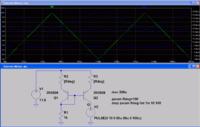Darkcobra
Member level 3
The actual current output of a simple two-transistor bipolar current mirror changes with the voltage at the output terminal. I'm trying to reduce this without using a higher part count mirror (no Wilson, Widlar, etc).
I've tried with the transistors on hand, the 2222/2907 and 3904/3906. The latter performed much better, but not as well as I'd like, and I think there must be better transistors for the task. My questions:
1) What spec(s) should I compare in a datasheet that would indicate how well a transistor will work for this purpose?
2) Finding a transistor with the desired specs out of the thousands available is a bit overwhelming. Though I can filter by various specs on some vendor sites, this tells me nothing about how common the parts are; and I'd like to limit my designs to the most common and widely available types as much as possible (for the United States). I've searched for "common transistors", but generally find only the 2222/2907 and 3904/3906 that I already have mentioned. I'd like to find others, and if there's a "top ten" list out there somewhere, that would be perfect. Does such a thing exist? Failing that,
3) Can you recommend a common and widely available transistor that would perform better than 3904/3906, preferably available in both TO-92 and SMD?
I've tried with the transistors on hand, the 2222/2907 and 3904/3906. The latter performed much better, but not as well as I'd like, and I think there must be better transistors for the task. My questions:
1) What spec(s) should I compare in a datasheet that would indicate how well a transistor will work for this purpose?
2) Finding a transistor with the desired specs out of the thousands available is a bit overwhelming. Though I can filter by various specs on some vendor sites, this tells me nothing about how common the parts are; and I'd like to limit my designs to the most common and widely available types as much as possible (for the United States). I've searched for "common transistors", but generally find only the 2222/2907 and 3904/3906 that I already have mentioned. I'd like to find others, and if there's a "top ten" list out there somewhere, that would be perfect. Does such a thing exist? Failing that,
3) Can you recommend a common and widely available transistor that would perform better than 3904/3906, preferably available in both TO-92 and SMD?
